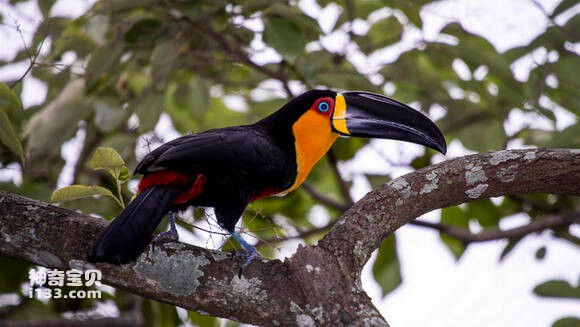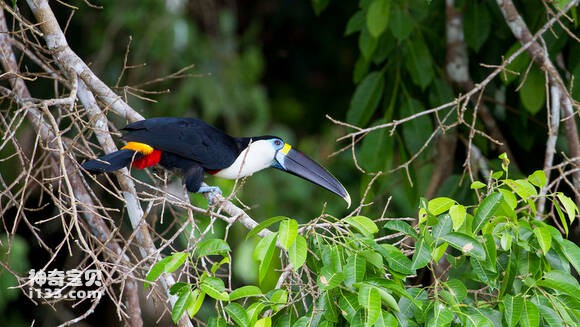Ramphastos vitellinus
IUCN
LCBasic Information
Scientific classification
- name:Ramphastos vitellinus
- Scientific Name:Ramphastos vitellinus,Channel-billed Toucan
- Outline:Climbing birds
- Family:
Vital signs
- length:About 60 cm
- Weight:No textual research information is available
- lifetime:No textual research information is available
Feature
Distribution and Habitat
It is found in South America (Colombia, Venezuela, Guyana, Suriname, Ecuador, Peru, Bolivia, Paraguay, Brazil, Chile, Argentina, Uruguay, and the Malvinas Islands (also known as the Falkland Islands).
The hollow-billed toucan lives mainly in lowland rain forests, sometimes in open areas with sparse trees nearby. They are rarely seen above 1,700 metres above sea level.
Appearance
The toucan resembles a hornbill and can reach a length of 60 cm. The body feathers are mainly black or chestnut black, the throat and chest are white, and some are lemon yellow, the ventral side of the tail is bright red, the mouth is mainly black, and the base has a circle of sky blue. The nostrils of the adult bird are hidden under the base of the beak. A bird's beak is actually very light, not nearly as heavy as it looks. The outside is a thin sheath of keratin, the inside is hollow, but there are many thin bone support rods staggered. The tongue of the pitted toucan is very long, the margin of the beak is clearly serrated, and there is no mouth beard around the base of the beak. The bare eyelids are usually bright blue.
Details
Ramphastos vitellinus, also known as Channel-billed Toucan, is a medium-sized climbing bird.

The pit-billed toucan's song is hoarse and low. The pitted toucan eats the fruits and seeds of plants. Instead of pecking with its beak like some birds, it throws food into the air and then opens its big beak to accurately put the food down its throat. The advantage of this is that the food does not have to pass through its long mouth, which greatly simplifies the eating process. They also sometimes raid the nests of young birds and eat the eggs and chicks.

Hollow-billed toucans live in rainforests and like to travel in groups because their ancestors taught them early on that collective action is better than fighting alone. In the group, there is always a bird acting as a sentinel, guarding around the birds with high vigilance, so that no matter how happy the companions are playing, they can find the enemy in time to prevent a sudden attack.

Both parents share brooding tasks, but are often impatient and rarely sit for more than an hour. They are easily frightened, will immediately fly away from the nest at the slightest disturbance, and often do not cover the eggs.
The hollow bill Toucan nests in tree holes, and the preferred holes are good wood, the opening width is just enough for the adult bird to drill into, and the hole is 17 cm to 2 meters deep. The presence of suitable burrows near the root of the tree will also attract birds that normally nest in high places to nest near the ground. - Lay 2 to 4 eggs. Smooth white eggs are piled in unlined holes and hatch in about 16 days. The hatchlings are completely naked and need at least three weeks to open their eyes, and after hatching, it takes more than 50 days for the chicks to live their lives independently in the leaf cluster.
Listed on the IUCN Red List of Threatened Species (IUCN) for 2016 ver 3.1 - Vulnerable (VU).
Listed in Appendices I, II and III of the Convention on International Trade in Endangered Species of Wild Fauna and Flora (CITES) 2019 edition Appendix II.
Protect wild animals and eliminate wild meat.
Maintaining ecological balance is everyone's responsibility!








